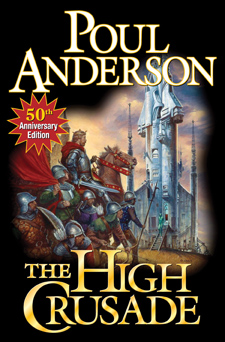This year marks the 50th anniversary of the publication of Poul Anderson’s The High Crusade in the pages of Astounding magazine (later to be known as Analog that very year). In celebration, Baen Books is releasing an anniversary paperback edition on Tuesday, September 7th, with appreciations from some of science fiction’s greatest names.
Tor.com will be posting these appreciations throughout Monday and Tuesday of this week, courtesy of Baen Books. These appreciations originally appeared at WebScription, where you can also sample the first few chapters of The High Crusade.
I bought the Astounding (it was in the process of changing its name to Analog, so both names are on the cover) with the first installment of The High Crusade on the newsstand. I didn’t have a subscription to the magazine; I’d read a couple issues, but nothing in them had really blown me away.
I was a working-class fourteen-year-old. I loved SF, but cost was a real factor in my decisions.
The cover of a knight standing in front of a forest of spaceships got my initial fifty cents. I read the installment and immediately subscribed to the magazine. I didn’t care whether it was called Astounding or Analog: if it occasionally ran stories like The High Crusade, it was worth my money.
Even in John W. Campbell’s last decade as editor, Analog ran very good stories more than occasionally. Many of them were written by Poul Anderson.
The High Crusade was a typical Poul Anderson story in that it combined action and characterization into something both readable and memorable—note that it’s fifty years later and I remember this novel. It’s also typical that these exceptional story values overlaid a very thoughtful core. In this particular case, that core is: technology is not intelligence.
I referred to this as the core, not the theme, because “theme” would make The High Crusade sound as though it were a candy-coated lesson plan; which would be utter nonsense. Not everything Poul wrote was funny (I don’t recall cracking a smile when I read The Pugilist), but humor is generally there, and this novel is one of his absolutely deadpan funniest. The scene of the old executioner/torturer’s delight at finally getting a chance to put his skills to work makes me giggle every time I think of it.
And that leads me to a final point, something that I didn’t notice until I reread the novel before writing this essay. Besides the third installment of The High Crusade, the September, 1960 issue of Astounding/Analog has a Poul Anderson novelette, Barnacle Bull. It was rare for a magazine to run two stories under the same author’s name in an issue: the novelette was credited to Winston P. Sanders, a pseudonym that Poul used a number of times.
The name is a joke. If you’ve read Winnie-the-Pooh, you may recall that Winnie is living “under the name of Sanders.” (The Ernest Shepherd illustration shows him sitting on a log porch; the sign over the door behind him reads Mr. Sanders.) Poul was crediting Barnacle Bull to Winnie-the-Pooh.
How is this important to The High Crusade? Notice the name of the monk telling the story: Brother Parvus, a church name which he tells us he took from his nickname as a layman. So: his nickname was Little. He also tells us that he was a younger son of Wat Brown.
Very coyly Poul has told us that the novel is by Little Brown, a very upmarket Boston publisher who most certainly did not publish The High Crusade or anything else by Poul Anderson until quite late in his life. I wish I’d noticed this a long time ago, when I could have asked Poul about it. Now it’s just one more piece of whimsy and invention and sheer delight to savor in The High Crusade.
Bestselling author David Drake can be found online at david-drake.com; his newest novel, What Distant Deeps, will be released by Baen Books on September 7th.










